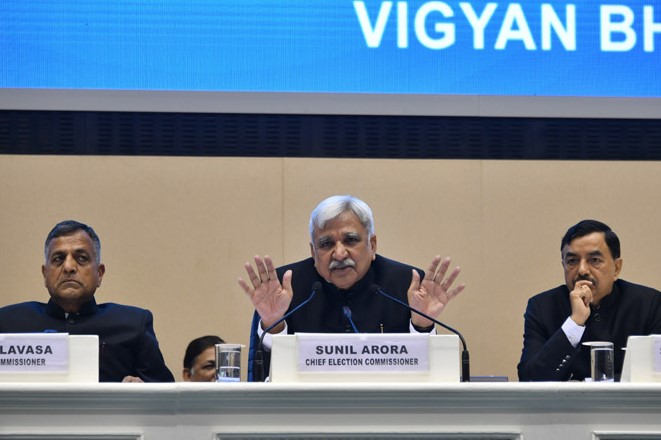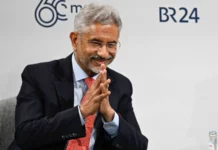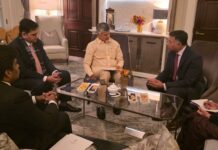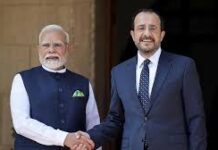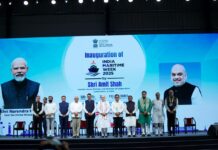NEW DELHI: Lok Sabha elections will begin on April 11 and continue for over a month till May 19 across seven phases, followed by counting of votes on May 23, the Election Commission announced Sunday, kick-starting a mega electoral battle where the BJP will pitch for a re-election of the Modi government amid the Opposition’s efforts for a united fight to unseat it.
The polling will be held on April 11, April 18, April 23, April 29, May 6, May 12 and May 19 for 543 Lok Sabha seats across the country in which nearly 90 crore voters would be eligible to vote, Chief Election Commissioner Sunil Arora told a packed press conference here.
Assembly elections will also be held in Andhra Pradesh, Sikkim, Arunachal Pradesh and Odisha simultaneously with the Lok Sabha polls, the CEC said.
However, elections for Jammu and Kashmir assembly have been deferred, the EC said citing security reasons. The state has been under President’s Rule after the ruling alliance between the BJP and Peoples Democratic Party fell apart last year.
National Conference, Congress and other opposition parties slammed the decision to not hold assembly polls in J&K, while opposition leaders elsewhere including in West Bengal latched onto the EC decision to hold multi-phase elections in their states to slam the government on law and order situation.
Polling for parliamentary and assembly elections in Andhra Pradesh, Arunachal and Sikkim will be held in the first phase on April 11. Parliamentary and assembly polls will be held in Odisha across the first four phases.
Twenty-two states and union territories (UTs), including Andhra Pradesh, Tamil Nadu and Telangana, will have Lok Sabha election in a single phase while it will be spread across seven phases in Uttar Pradesh, Bihar and West Bengal.
Karnataka, Manipur, Rajasthan and Tripura will have Lok Sabha election in two phases, while Assam and Chhattisgarh will have three-phase polling.
Four states — Jharkhand, Madhya Pradesh, Maharashtra and Odisha — will have elections in four phases. Jammu and Kashmir will have five-phase voting.
The Chief Election Commissioner said the model code of conduct would come into immediate effect from Sunday.
Among other restrictions, the model code bars the government from announcing any policy move that may impact voters’ decision.
The EC said the ‘voter verifiable paper audit trail’ (VVPAT) will be used in all polling stations this time. Ten lakhs polling stations would be set up this time as against about nine lakhs in 2014. EVMs and postal ballots will carry pictures of candidates.
In 2014, the BJP had won 282 seats handing a crushing defeat to the 10-year-rule of the United Progressive Alliance led by Congress.
While Prime Minister Narendra Modi will seek to retain power, the opposition is seeking to put up a spirited fight to defeat the ruling BJP.
“Best wishes to the Election Commission, all those officials and security personnel who will be on the field, across the length and breadth of India assuring smooth elections. India is very proud of the EC for assiduously organising elections for several years,” Modi tweeted.
In the press briefing, Arora said all political advertisements on social media will need pre-certification and the candidates will have to give details of their social media accounts to the EC.
The CEC said 91 constituencies will go for polls in first phase, 97 in second phase, 115 in third phase, 71 in fourth, 51 in fifth, 59 in sixth and 59 in the seventh phase.
The election will pit the BJP-led National Democratic Alliance against mostly different opposition groupings in various states, including of Congress, Left and regional forces who are continuing to work out a grand alliance to minimise a division of votes against the BJP.
The BJP has worked out a seat-sharing formula with some new allies and several old partners, by even making concessions in states such as Bihar, which has 40 seats. However, opposition parties are yet to do so in several states.
While the NDA hopes to make history by coming back to power for a second full term, the Opposition wants to unseat the Modi dispensation by raising questions on its performance on a host of issues, including economic growth, unemployment, corruption and social harmony.
Atal Bihari Vajpayee had led the NDA to back-to-back wins in 1998 and 1999 general elections but he was at the helm for only one full term.
After losing three state polls last year, the BJP believes its Lok Sabha campaign is back on track following decisions such as 10 per cent quota for the general category poor, money transfer to farmers and a populist budget.
What has injected further confidence into the NDA fold is the fronting of the nationalist plank in the poll campaign after the Indian Air Force’s strikes on terrorist camps in Pakistan after the Pulwama terror attack, which killed 40 CRPF personnel.
The BJP has been citing 2016 surgical strikes on terror launch pads and the Balakot air strikes to assert that only a government headed by Modi will be capable of taking on Pakistan over terrorism.
Modi has launched an aggressive campaign accusing the opposition of coming together for the sole purpose of removing him when he is working to “remove poverty, corruption and terrorism”.
He had led the NDA to a sweeping victory in 2014 as it won 336 seats, reducing the incumbent Congress to its lowest total of 44 seats.
In 2014, Lok Sabha polls were held in nine phases beginning April 7 and ending May 9. Votes were counted on May 16. PTI

